warning light Seat Exeo 2008 User Guide
[x] Cancel search | Manufacturer: SEAT, Model Year: 2008, Model line: Exeo, Model: Seat Exeo 2008Pages: 303, PDF Size: 10.02 MB
Page 44 of 303
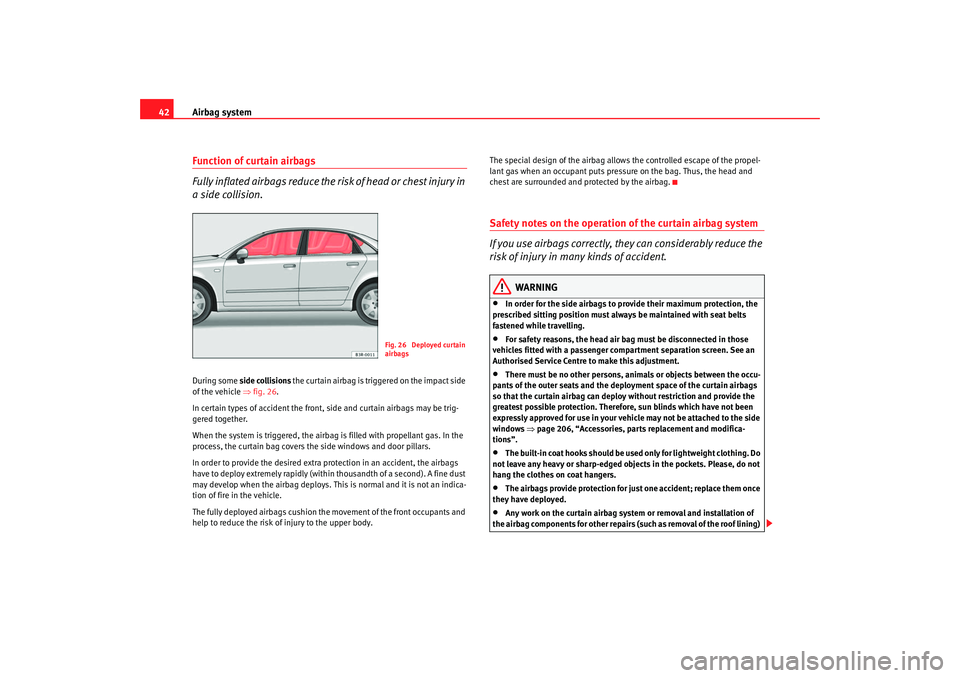
Airbag system
42Function of curtain airbags
Fully inflated airbags reduce the ri sk of head or chest injury in
a side collision.During some side collisions the curtain airbag is tri ggered on the impact side
of the vehicle ⇒fig. 26 .
In certain types of accident the front, side and curtain airbags may be trig-
gered together.
When the system is triggered, the airbag is filled with propellant gas. In the
process, the curtain bag covers the side windows and door pillars.
In order to provide the desired extra protection in an accident, the airbags
have to deploy extremely rapidly (within thousandth of a second). A fine dust
may develop when the airbag deploys. This is normal and it is not an indica-
tion of fire in the vehicle.
The fully deployed airbags cushion the movement of the front occupants and
help to reduce the risk of injury to the upper body. The special design of the airbag allows the controlled escape of the propel-
lant gas when an occupant puts pressure on the bag. Thus, the head and
chest are surrounded and protected by the airbag.
Safety notes on the operation of the curtain airbag system
If you use airbags correctly, they can considerably reduce the
risk of injury in many kinds of accident.
WARNING
•
In order for the side airbags to provide their maximum protection, the
prescribed sitting position must alwa ys be maintained with seat belts
fastened while travelling.
•
For safety reasons, the head air bag must be disconnected in those
vehicles fitted with a passenger compartment separation screen. See an
Authorised Service Centre to make this adjustment.
•
There must be no other persons, animals or objects between the occu-
pants of the outer seats and the depl oyment space of the curtain airbags
so that the curtain airbag can deploy without restriction and provide the
greatest possible protection. Therefor e, sun blinds which have not been
expressly approved for use in your vehicle may not be attached to the side
windows ⇒page 206, “Accessories, parts replacement and modifica-
tions”.
•
The built-in coat hooks should be us ed only for lightweight clothing. Do
not leave any heavy or sharp-edged objects in the pockets. Please, do not
hang the clothes on coat hangers.
•
The airbags provide protection for just one accident; replace them once
they have deployed.
•
Any work on the curtain airbag system or removal and installation of
the airbag components for other repairs (such as removal of the roof lining)
Fig. 26 Deployed curtain
airbags
Exeo_EN.book Seite 42 Freitag, 17. Oktober 2008 11:24 11
Page 47 of 303
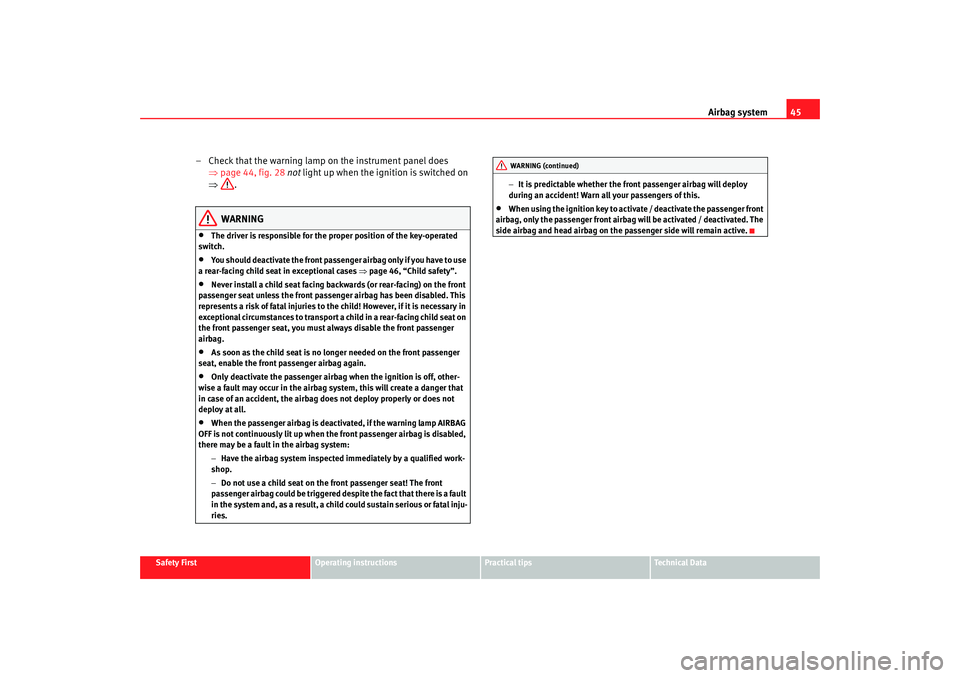
Airbag system45
Safety First
Operating instructions
Practical tips
Te c h n i c a l D a t a
– Check that the warning lamp on the instrument panel does
⇒page 44, fig. 28 not light up when the ignition is switched on
⇒ .
WARNING
•
The driver is responsible for the proper position of the key-operated
switch.
•
You should deactivate the front passenger airbag only if you have to use
a rear-facing child seat in exceptional cases ⇒page 46, “Child safety”.
•
Never install a child seat facing backwards (or rear-facing) on the front
passenger seat unless the front passenger airbag has been disabled. This
represents a risk of fatal injuries to th e child! However, if it is necessary in
exceptional circumstances to transport a child in a rear-facing child seat on
the front passenger seat, you must always disable the front passenger
airbag.
•
As soon as the child seat is no longer needed on the front passenger
seat, enable the front passenger airbag again.
•
Only deactivate the passenger airbag when the ignition is off, other-
wise a fault may occur in the airbag system, this will create a danger that
in case of an accident, the airbag do es not deploy properly or does not
deploy at all.
•
When the passenger airbag is deactivated, if the warning lamp AIRBAG
OFF is not continuously lit up when the front passenger airbag is disabled,
there may be a fault in the airbag system:
−Have the airbag system inspected immediately by a qualified work-
shop.
− Do not use a child seat on the front passenger seat! The front
passenger airbag could be triggered despite the fact that there is a fault
in the system and, as a result, a child could sustain serious or fatal inju-
ries. −
It is predictable whether the front passenger airbag will deploy
during an accident! Warn all your passengers of this.
•
When using the ignition key to activate / deactivate the passenger front
airbag, only the passenger front airbag will be activated / deactivated. The
side airbag and head airbag on the passenger side will remain active.WARNING (continued)
Exeo_EN.book Seite 45 Freitag, 17. Oktober 2008 11:24 11
Page 59 of 303
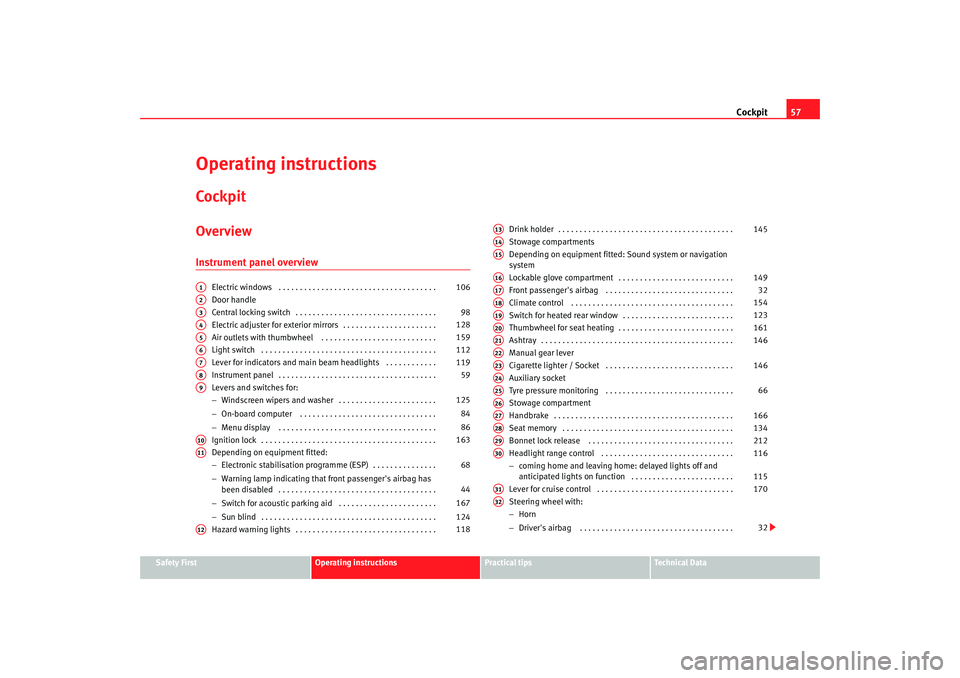
Cockpit57
Safety First
Operating instructions
Practical tips
Te c h n i c a l D a t a
Operating instructionsCockpitOverviewInstrument panel overview
Electric windows . . . . . . . . . . . . . . . . . . . . . . . . . . . . . . . . . . . . .
Door handle
Central locking switch . . . . . . . . . . . . . . . . . . . . . . . . . . . . . . . . .
Electric adjuster for exterior mirrors . . . . . . . . . . . . . . . . . . . . . .
Air outlets with thumbwheel . . . . . . . . . . . . . . . . . . . . . . . . . . .
Light switch . . . . . . . . . . . . . . . . . . . . . . . . . . . . . . . . . . . . . . . . .
Lever for indicators and main beam headlights . . . . . . . . . . . .
Instrument panel . . . . . . . . . . . . . . . . . . . . . . . . . . . . . . . . . . . . .
Levers and switches for:
−Windscreen wipers and washer . . . . . . . . . . . . . . . . . . . . . . .
− On-board computer . . . . . . . . . . . . . . . . . . . . . . . . . . . . . . . .
− Menu display . . . . . . . . . . . . . . . . . . . . . . . . . . . . . . . . . . . . .
Ignition lock . . . . . . . . . . . . . . . . . . . . . . . . . . . . . . . . . . . . . . . . .
Depending on equipment fitted:
− Electronic stabilisation programme (ESP) . . . . . . . . . . . . . . .
− Warning lamp indicating that front passenger's airbag has
been disabled . . . . . . . . . . . . . . . . . . . . . . . . . . . . . . . . . . . . .
− Switch for acoustic parking aid . . . . . . . . . . . . . . . . . . . . . . .
− Sun blind . . . . . . . . . . . . . . . . . . . . . . . . . . . . . . . . . . . . . . . . .
Hazard warning lights . . . . . . . . . . . . . . . . . . . . . . . . . . . . . . . . . Drink holder . . . . . . . . . . . . . . . . . . . . . . . . . . . . . . . . . . . . . . . . .
Stowage compartments
Depending on equipment fitted: Sound system or navigation
system
Lockable glove compartment . . . . . . . . . . . . . . . . . . . . . . . . . . .
Front passenger's airbag . . . . . . . . . . . . . . . . . . . . . . . . . . . . . .
Climate control . . . . . . . . . . . . . . . . . . . . . . . . . . . . . . . . . . . . . .
Switch for heated rear window . . . . . . . . . . . . . . . . . . . . . . . . . .
Thumbwheel for seat heating . . . . . . . . . . . . . . . . . . . . . . . . . . .
Ashtray . . . . . . . . . . . . . . . . . . . . . . . . . . . . . . . . . . . . . . . . . . . . .
Manual gear lever
Cigarette lighter / Socket . . . . . . . . . . . . . . . . . . . . . . . . . . . . . .
Auxiliary socket
Tyre pressure monitoring . . . . . . . . . . . . . . . . . . . . . . . . . . . . . .
Stowage compartment
Handbrake . . . . . . . . . . . . . . . . . . . . . . . . . . . . . . . . . . . . . . . . . .
Seat memory . . . . . . . . . . . . . . . . . . . . . . . . . . . . . . . . . . . . . . . .
Bonnet lock release . . . . . . . . . . . . . . . . . . . . . . . . . . . . . . . . . .
Headlight range control . . . . . . . . . . . . . . . . . . . . . . . . . . . . . . .
−
coming home and leaving home : delayed lights off and
anticipated lights on function . . . . . . . . . . . . . . . . . . . . . . . .
Lever for cruise control . . . . . . . . . . . . . . . . . . . . . . . . . . . . . . . .
Steering wheel with:
− Horn
− Driver's airbag . . . . . . . . . . . . . . . . . . . . . . . . . . . . . . . . . . . .
A1
106
A2A3
98
A4
128
A5
159
A6
112
A7
119
A8
59
A9
125
84
86
A10
163
A11
68
44
167
124
A12
118
A13
145
A14A15A16
149
A17
32
A18
154
A19
123
A20
161
A21
146
A22A23
146
A24A25
66
A26A27
166
A28
134
A29
212
A30
116
115
A31
170
A32
32
Exeo_EN.book Seite 57 Freitag, 17. Oktober 2008 11:24 11
Page 61 of 303

Cockpit59
Safety First
Operating instructions
Practical tips
Te c h n i c a l D a t a
InstrumentsInstrument panel overview
The instrument panel is the driver's information centre.Fig. 37 Overview of instrument panel
Coolant temperature gauge . . . . . . . . . . . . . . . . . . . . . . . . . . . .
Rev counter incorporating digital clock and date . . . . . . . . . . .
Warning and indicator lamps . . . . . . . . . . . . . . . . . . . . . . . . . . .
Speedometer (incorporating mileage recorder display) . . . . . .
Fuel gauge . . . . . . . . . . . . . . . . . . . . . . . . . . . . . . . . . . . . . . . . . . Adjuster buttons for
−
Digital clock and date . . . . . . . . . . . . . . . . . . . . . . . . . . . . . .
− Instrument lighti ng . . . . . . . . . . . . . . . . . . . . . . . . . . . . . . . . .
Digital display with
− Service indicator . . . . . . . . . . . . . . . . . . . . . . . . . . . . . . . . . . .
A1
60
A2
61, 61
A3
65
A4
63
A5
63
A6
61
62
A7
74
Exeo_EN.book Seite 59 Freitag, 17. Oktober 2008 11:24 11
Page 62 of 303
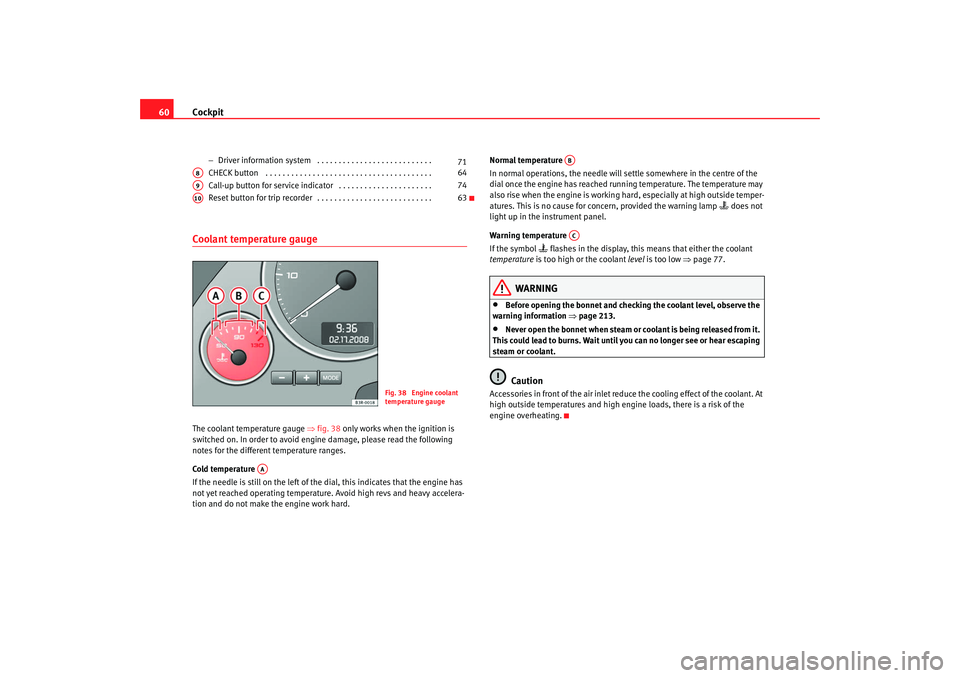
Cockpit
60
− Driver information system . . . . . . . . . . . . . . . . . . . . . . . . . . .
CHECK button . . . . . . . . . . . . . . . . . . . . . . . . . . . . . . . . . . . . . . .
Call-up button for service indicator . . . . . . . . . . . . . . . . . . . . . .
Reset button for trip recorder . . . . . . . . . . . . . . . . . . . . . . . . . . .
Coolant temperature gaugeThe coolant temperature gauge ⇒fig. 38 only works when the ignition is
switched on. In order to avoid engine damage, please read the following
notes for the different temperature ranges.
Cold temperature
If the needle is still on the left of the dial, this indicates that the engine has
not yet reached operating temperature. Avoid high revs and heavy accelera-
tion and do not make the engine work hard. Normal temperature
In normal operations, the needle will settle somewhere in the centre of the
dial once the engine has reached running temperature. The temperature may
also rise when the engine is working hard, especially at high outside temper-
atures. This is no cause for conc
ern, provided the warning lamp
does not
light up in the instrument panel.
Warning temperature
If the symbol
flashes in the display, this means that either the coolant
temperature is too high or the coolant level is too low ⇒page 77.
WARNING
•
Before opening the bonnet and checking the coolant level, observe the
warning information ⇒ page 213.
•
Never open the bonnet when steam or coolant is being released from it.
This could lead to burns. Wait until you can no longer see or hear escaping
steam or coolant.Caution
Accessories in front of the air inlet reduce the cooling effect of the coolant. At
high outside temperatures and high engine loads, there is a risk of the
engine overheating.
71
A8
64
A9
74
A10
63
Fig. 38 Engine coolant
temperature gauge
AA
ABAC
Exeo_EN.book Seite 60 Freitag, 17. Oktober 2008 11:24 11
Page 66 of 303
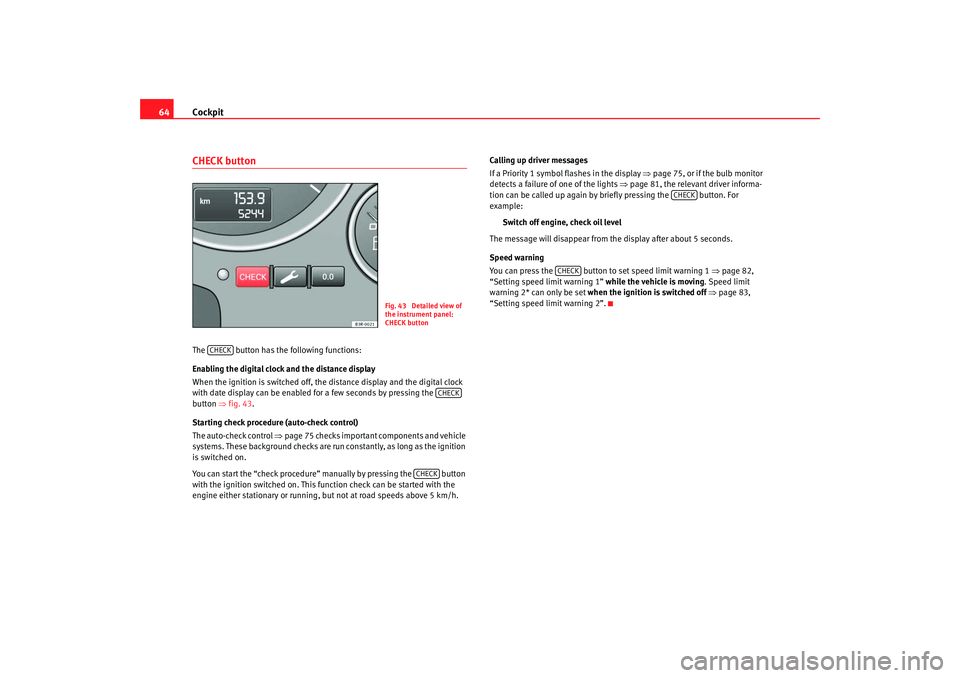
Cockpit
64CHECK buttonThe button has the following functions:
Enabling the digital clock and the distance display
When the ignition is switched off, the distance display and the digital clock
with date display can be enabled for a few seconds by pressing the
button ⇒ fig. 43.
Starting check procedure (auto-check control)
The auto-check control ⇒page 75 checks important components and vehicle
systems. These background checks are ru n constantly, as long as the ignition
is switched on.
You can start the “check procedure” manually by pressing the button
with the ignition switched on. This function check can be started with the
engine either stationary or running, but not at road speeds above 5 km/h. Calling up driver messages
If a Priority 1 symbol flashes in the display
⇒page 75, or if the bulb monitor
detects a failure of one of the lights ⇒page 81, the relevant driver informa-
tion can be called up again by briefly pressing the button. For
example:
Switch off engine, check oil level
The message will disappear from the display after about 5 seconds.
Speed warning
You can press the button to set speed limit warning 1 ⇒page 82,
“Setting speed limi t warning 1” while the vehicle is moving . Speed limit
warning 2* can only be set when the ignition is switched off ⇒page 83,
“Setting speed limi t warning 2”.
Fig. 43 Detailed view of
the instrument panel:
CHECK button
CHECK
CHECK
CHECK
CHECK
CHECK
Exeo_EN.book Seite 64 Freitag, 17. Oktober 2008 11:24 11
Page 67 of 303

Cockpit65
Safety First
Operating instructions
Practical tips
Te c h n i c a l D a t a
Warning and indicator lampsGeneral description
The warning and indicator lamps indicate a number of
different functions and possible faults.Fig. 44 Instrument panel with warning and indicator lamps
Note
A number of functions are monito red by the auto-check control ⇒page 75. If
a malfunction should occur, this will be shown by the display in the instru-
ment cluster either with a red symbol (priority 1 - danger) or a yellow symbol
(priority 2 - warning).
Exhaust emission control system
⇒ page 66
Airbag system
⇒page 66
Tyre pressure too low
⇒page 66
Cruise control
⇒page 67
Trailer indicato rs
⇒page 67
Anti-lock brake system (ABS)
⇒page 67
Seat belt warning
⇒page 68
Left indicators
⇒page 68
Electronic stabilisation programme (ESP)
⇒page 68
Alternator
⇒page 69
Main beam headlights
⇒page 69
Engine management (alternative to
)
⇒page 69
Glow plug system (alternative to
)
⇒page 70
Fault in brake system / handbrake is
applied
⇒page 70
Right indicators
⇒page 68
Exeo_EN.book Seite 65 Freitag, 17. Oktober 2008 11:24 11
Page 68 of 303

Cockpit
66Exhaust emission control system
If the warning lamp lights up continuously you should take your vehicle to a
specialist garage as soon as possible in order to have the fault rectified.
If the warning lamp flashes drive on at reduced speed and seek professional
help in order to avoid damage to the catalytic converter.
For further information on the catalytic converter ⇒page 182.Airbag system
This warning lamp monitors the airbag and belt tension
device system.The warning lamp
should light up for a few seconds when the ignition is
switched on.
If the warning lamp does not go out, or if it lights up, flashes or flickers when
the vehicle is moving, this indicates a malfunction in the system.
WARNING
If a malfunction should occur, have the system checked immediately by a
specialist garage. Otherwise there is a risk that the airbag system and/or
belt tensioners may not be triggered in an accident.
Tyre pressure monitoring display
The tyre pressure should be corrected as soon as possible if
it is too low.
Fig. 45 Display: system
faultFig. 46 Display: warning
message
Exeo_EN.book Seite 66 Freitag, 17. Oktober 2008 11:24 11
Page 69 of 303

Cockpit67
Safety First
Operating instructions
Practical tips
Te c h n i c a l D a t a
The yellow warning
lamp remains on if the system is faulty or if
the pressure is too low in at least one tyre. In the event of a system
fault, the letters TPMS are displayed in the centre of the instrument
panel ⇒page 66, fig. 45. In case the tyre pressure drops rapidly,
the message ⇒page 66, fig. 46 is shown on the central display
of the instrument panel. If the pressure loss is slowly, the message ⇒ page 66, fig. 46 is shown on the central display of the isntru-
ment panel. The message does not show the tyre affected. Should
any of these warnings be displayed:
– Stop the engine.
– Check the tyres. Although the warning corresponds to just one tyre, you should also check the others.
– Correct the tyre pressure ⇒page 228.
For more detailed information on the tyre pressure monitoring system, please
refer to ⇒page 227.Cruise control system*
The indicator lamp
on the instrument panel lights up when the cruise
control system is operating.
Trailer indicators*
This indicator lamp flashes when the indicators are operating
while towing a caravan or trailer.The indicator lamp
flashes when the indicators are operated if a trailer is
correctly coupled to the vehicle.
Where a turn signal lamp does not work, either on the trailer or on the towing
vehicle, the indicator lamp will not flash.
Anti-lock brake system (ABS)
The warning lamp monitors the ABS and the integrated elec-
tronic differential lock (EDL).The warning lamp
lights up for a few seconds when the ignition is
switched on and while the engine is being started. The lamp goes out again
after the system has run through an automatic test sequence.
There is a fault in the ABS if:
•
the warning lamp does not light up when the ignition is switched on,
•
The warning lamp does not go out again after a few seconds.
•
The warning lamp lights up when the vehicle is moving.
The vehicle can still brake in the normal way (except that the ABS control func-
tion is out of action). Please take the vehicle to a specialist garage as soon as
possible. For further information on the ABS ⇒page 176.
If a malfunction should occur in the ABS, the ESP warning lamp will also light
up.
AA
AB
Exeo_EN.book Seite 67 Freitag, 17. Oktober 2008 11:24 11
Page 70 of 303
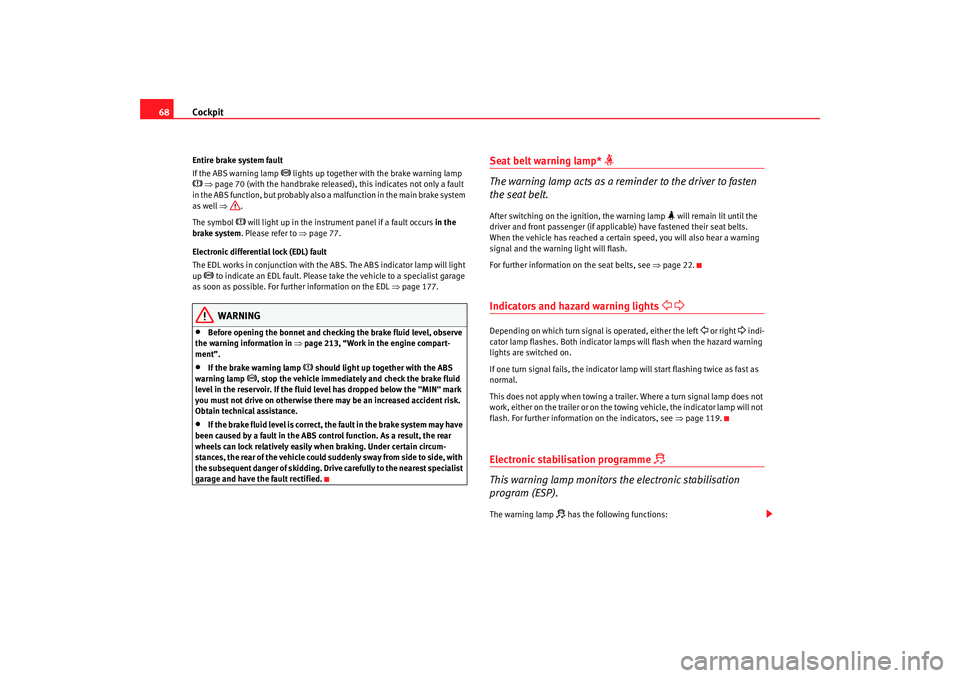
Cockpit
68Entire brake system fault
If the ABS warning lamp
lights up together with the brake warning lamp
⇒ page 70 (with the handbrake released), this indicates not only a fault
in the ABS function, but probably also a malfunction in the main brake system
as well ⇒ .
The symbol
will light up in the instrument panel if a fault occurs in the
brake system . Please refer to ⇒ page 77.
Electronic differential lock (EDL) fault
The EDL works in conjunction with the ABS. The ABS indicator lamp will light
up
to indicate an EDL fault. Please take the vehicle to a specialist garage
as soon as possible. For further information on the EDL ⇒page 177.WARNING
•
Before opening the bonnet and checki ng the brake fluid level, observe
the warning information in ⇒ page 213, “Work in the engine compart-
ment”.
•
If the brake warning lamp
should light up together with the ABS
warning lamp
, stop the vehicle immediately and check the brake fluid
level in the reservoir. If the fluid level has dropped below the "MIN" mark
you must not drive on otherwise ther e may be an increased accident risk.
Obtain technical assistance.
•
If the brake fluid level is correct, the fault in the brake system may have
been caused by a fault in the ABS control function. As a result, the rear
wheels can lock relatively easily when braking. Under certain circum-
stances, the rear of the vehicle could suddenly sway from side to side, with
the subsequent danger of skidding. Drive carefully to the nearest specialist
garage and have the fault rectified.
Seat belt warning lamp*
The warning lamp acts as a reminder to the driver to fasten
the seat belt.After switching on the ignition, the warning lamp
will remain lit until the
driver and front passenger (if applicable) have fastened their seat belts.
When the vehicle has reached a certain speed, you will also hear a warning
signal and the warning light will flash.
For further information on the seat belts, see ⇒page 22.
Indicators and hazard warning lights
Depending on which turn signal is operated, either the left
or right
indi-
cator lamp flashes. Both indicator lamp s will flash when the hazard warning
lights are switched on.
If one turn signal fails, the indicator lamp will start flashing twice as fast as
normal.
This does not apply when towing a trailer. Where a turn signal lamp does not
work, either on the trailer or on the towing vehicle, the indicator lamp will not
flash. For further informatio n on the indicators, see ⇒page 119.
Electronic stabilisation programme
This warning lamp monitors the electronic stabilisation
program (ESP).The warning lamp
has the following functions:
Exeo_EN.book Seite 68 Freitag, 17. Oktober 2008 11:24 11